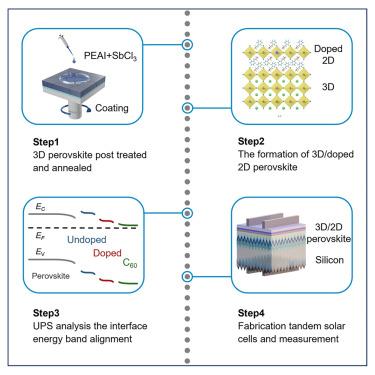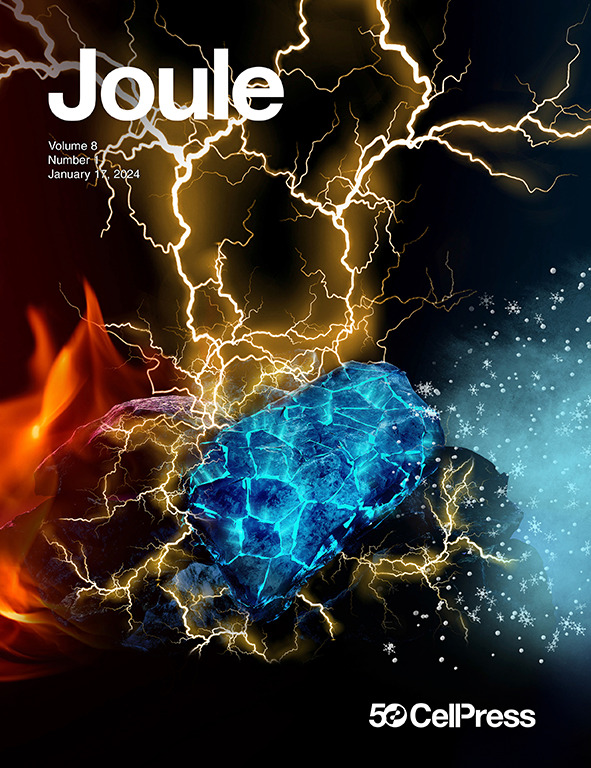高效钙钛矿-硅串联太阳能电池中二维钙钛矿中间层的n型调控
IF 35.4
1区 材料科学
Q1 CHEMISTRY, PHYSICAL
引用次数: 0
摘要
在倒置太阳能电池中,钙钛矿/C60界面的界面缺陷和不平衡电荷提取驱动了非辐射复合,限制了其功率转换效率(pce)。虽然二维(2D)钙钛矿钝化层减轻了表面缺陷,但其固有的量子限制和较差的电导率阻碍了载流子传输和能带对齐。在这里,我们提出了一种二维钙钛矿间层的n型调节策略,同时抑制缺陷和优化界面能量。通过将三氯化锑(SbCl3)掺入到苯乙基碘化铵(PEAI)基二维钙钛矿中,在二维钝化层中实现了n型掺杂,显著增强了其电子密度,在钙钛矿/C60界面处形成场效应,增强了钝化效果。这种可控的n型调制改变了界面带弯曲,抑制了空穴回流,减少了界面处的复合。由此产生的协同作用能够以最小的接触损失高效提取载流子,产生超过33%的钙钛矿-硅串联效率(经认证为32.56%),并提高了操作稳定性。本文章由计算机程序翻译,如有差异,请以英文原文为准。

n-type regulation of 2D perovskite interlayers for efficient perovskite-silicon tandem solar cells
Interfacial defects and imbalanced charge extraction at the perovskite/C60 interface in inverted solar cells drive non-radiative recombination, limiting their power conversion efficiencies (PCEs). While two-dimensional (2D) perovskite passivation layers mitigate surface defects, their inherent quantum confinement and poor conductivity hinder carrier transport and energy band alignment. Here, we present an n-type regulation strategy in 2D perovskite interlayers to simultaneously suppress defects and optimize interfacial energetics. By incorporating antimony trichloride (SbCl3) into phenylethylammonium iodide (PEAI)-based 2D perovskites, we achieved n-type doping in the 2D passivation layer markedly enhancing its electron density, building up a field effect to enhance the passivation at the perovskite/C60 interface. This controlled n-type modulation reshapes interfacial band bending, suppresses hole backflow, and reduces recombination at the interface. The resulting synergy enables efficient carrier extraction with minimal contact loss, yielding a perovskite-silicon tandem efficiency over 33% (certified 32.56%) with improved operational stability.
求助全文
通过发布文献求助,成功后即可免费获取论文全文。
去求助
来源期刊

Joule
Energy-General Energy
CiteScore
53.10
自引率
2.00%
发文量
198
期刊介绍:
Joule is a sister journal to Cell that focuses on research, analysis, and ideas related to sustainable energy. It aims to address the global challenge of the need for more sustainable energy solutions. Joule is a forward-looking journal that bridges disciplines and scales of energy research. It connects researchers and analysts working on scientific, technical, economic, policy, and social challenges related to sustainable energy. The journal covers a wide range of energy research, from fundamental laboratory studies on energy conversion and storage to global-level analysis. Joule aims to highlight and amplify the implications, challenges, and opportunities of novel energy research for different groups in the field.
 求助内容:
求助内容: 应助结果提醒方式:
应助结果提醒方式:


